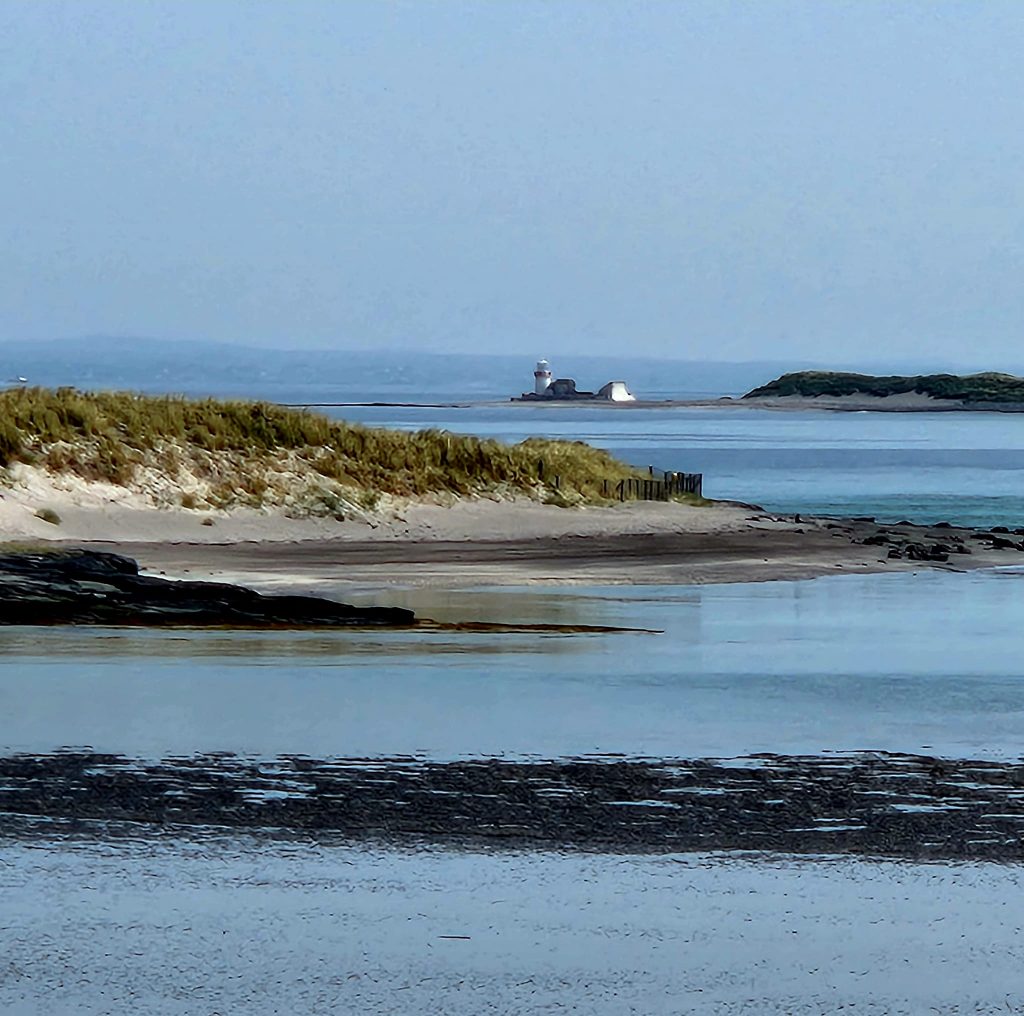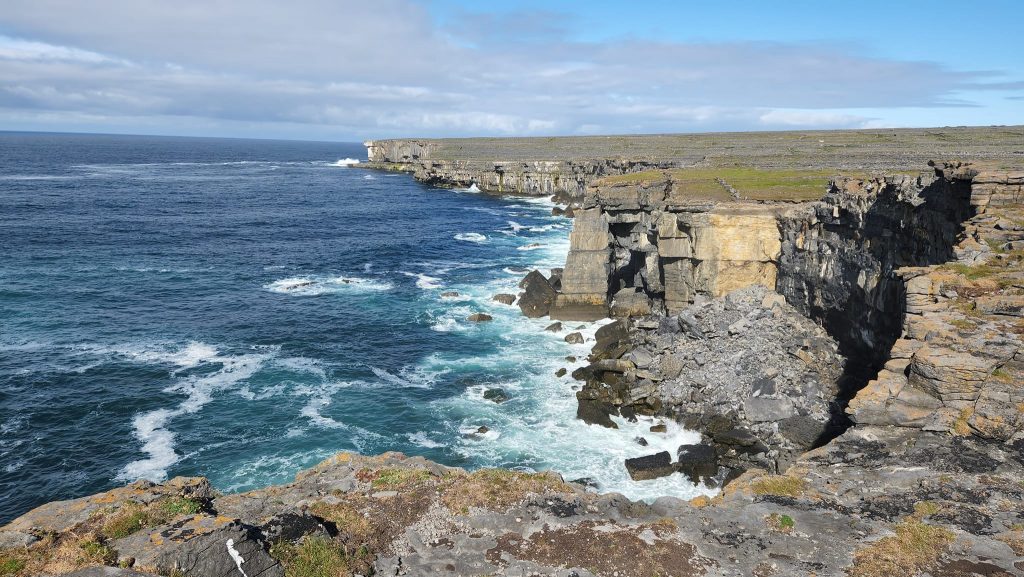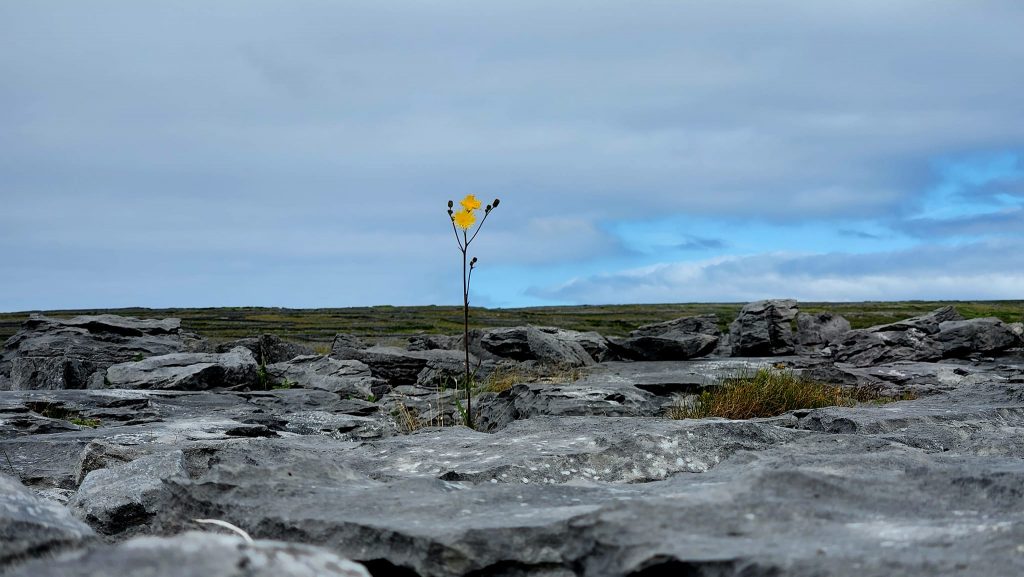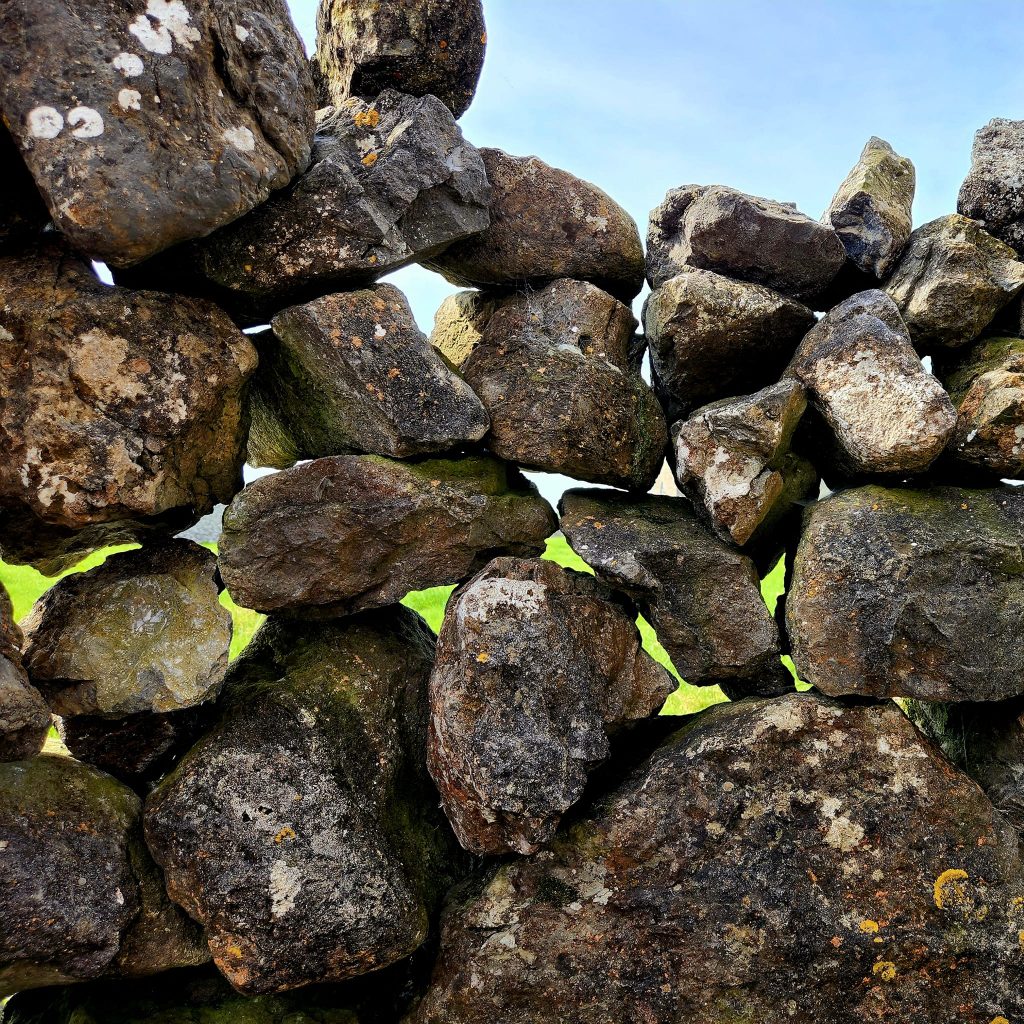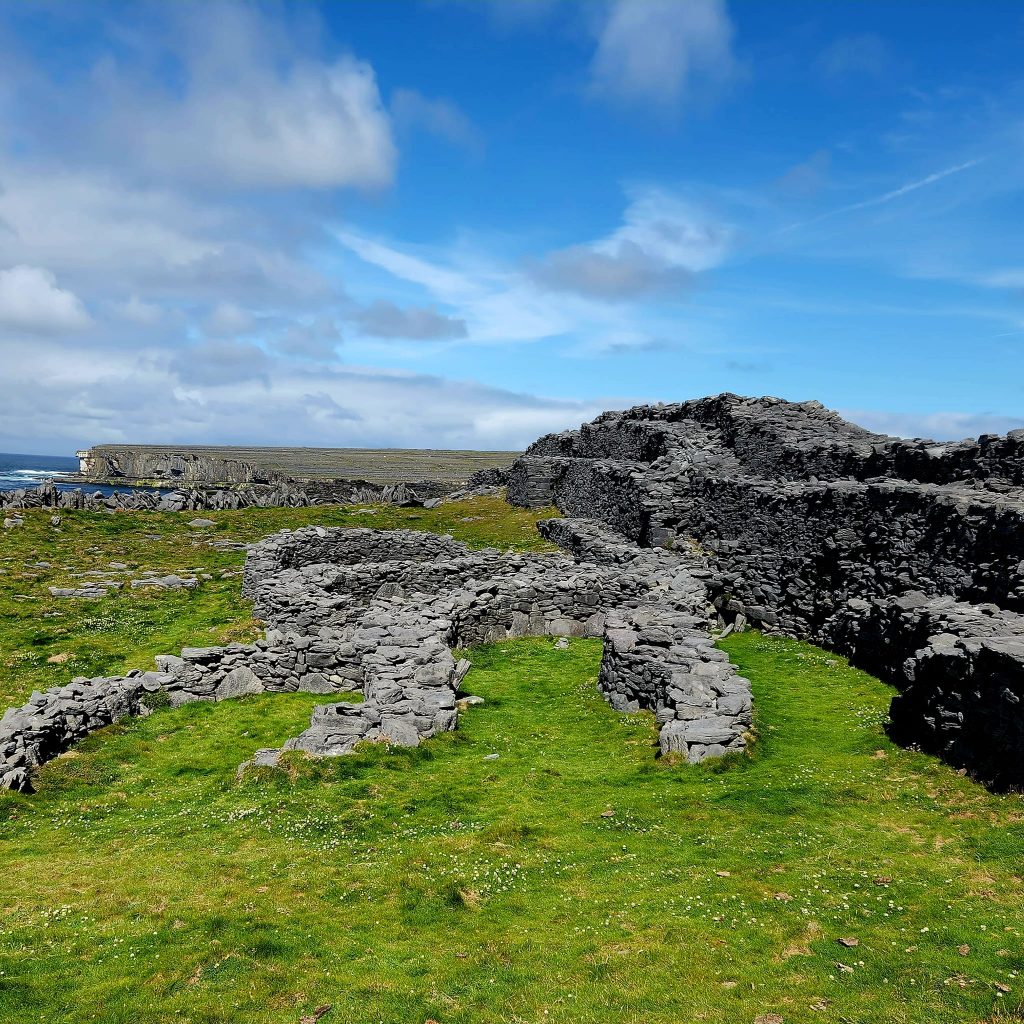Pilgrimage to Ireland: Thin Places, Big Hearts

Pilgrimage to Ireland: Thin Places, Big Hearts is my thirteenth attempt to write this essay. And it has been through that many revisions.
Because I have struggled to tell the truth of it.
I feel a sense of responsibility to write this essay as if I am a travel guide writer. A voice in my head says, “Speak only of the magic and poetry of the place. How verdant and green it is, how magical and mystical it is, and how lovely and inviting the people are.” (And leave yourself out of it!)
What? I write introspective memoir essays. That doesn’t change, whatever’s going on here! Thus, this thirteenth attempt may be the charm!
I always wanted to go to Ireland.
There was something about being a redhead in America with a hint of a tie to Ireland. Since childhood it filled my head and heart with dreams and visions of visiting the Emerald Isle.
 When I finally crossed the Atlantic at 61, I went to Inis Mór (Inishmore) as a pilgrim – on a religious and spiritual pilgrimage offered by The Celtic Center.
When I finally crossed the Atlantic at 61, I went to Inis Mór (Inishmore) as a pilgrim – on a religious and spiritual pilgrimage offered by The Celtic Center.
As a pilgrim, for me, the trip was about my favorite place of all – a place I never leave and that I always take with me. That’s my own internal world. There I meet the Divine and the Divine meets me. On this trip, my internal world met the external world of ancient Celtic Christian ruins and their history. It was magical!
But the trip itself, every single day of it, became more complex for a variety of reasons. Some were embarrassing and others mysterious, even frightening.
What is ancient Celtic Christianity?
Ancient Druids – who were religious leaders, lore keepers, legal authorities, even medical professionals – were the first converts to and leaders of ancient Christianity in Ireland. Their religious and spiritual knowledge, culture, and way of experiencing the world informed their conversion to and how they practiced Christianity.
For instance, because of the Druidic influence, which valued female leadership, ancient Celtic Christianity also had a high regard for women. Welcomed as leaders in the Celtic Christian monasteries and churches, they became priests and abbesses. In fact, they weren’t just welcome to be leaders, it was expected that they would be! That was back in the 400’s CE. 1600 years ago.
They also respected the individual soul’s inner wisdom and guidance.
With all these things appealing to me, I participated (and participate still) in a study and practice of Ancient Celtic Christianity online, at The Celtic Center. Dr. Kirk Webb offers classes and gatherings there.

The Celtic Center
The focus of The Celtic Center is ancient Celtic Christianity and what it can teach us. What the saints from that era can teach us, especially at this time in history.
To illustrate, today we humans desperately need a better and more respectful relationship with the natural world and our planet. And we need to embrace and respect diverse leadership in all areas of our lives. Ancient Celtic Christianity speaks to these vital issues.
Clarification regarding Druidism
 For the sake of clarity: we do not practice Druidism. It’s imprint on the ancient Celtic Christians was profound, though, and worthy of respect. In part because the conversion to Christianity was peaceful for 200 years, beginning in the early 5th Century. That speaks positively to the Christians that arrived, the first converts, and the Druids and other Celts that received them and the Gospel.
For the sake of clarity: we do not practice Druidism. It’s imprint on the ancient Celtic Christians was profound, though, and worthy of respect. In part because the conversion to Christianity was peaceful for 200 years, beginning in the early 5th Century. That speaks positively to the Christians that arrived, the first converts, and the Druids and other Celts that received them and the Gospel.
It’s also important to note that, during those two centuries, there was no organized Celtic Christian church. Nor was there a governing body for those that practiced Christianity in Ireland.
The beginning of the movement and growth of Christianity in Ireland seems to have been an organic phenomenon. Ireland’s people and Druid priests and priestesses embraced it because Christianity spoke powerfully to them.
The pilgrimage
My first year of study, I discovered that The Celtic Center sometimes offers a pilgrimage to Ireland – to Inis Mór. (The next pilgrimage will be July 14-19, 2024.)
Inis Mór is the largest of the Aran Islands off the western coast of Ireland. With its stark beauty, the large number of ancient Christian ruins, and how it isn’t easy to get there, make it a perfect location for a pilgrimage.
Though I’d always wanted to go to Ireland, I had no idea where to go or even how to begin to determine that. My interest in Ireland combined with the pilgrimage gave me what I needed – a focus. I had a place in Ireland to go to!
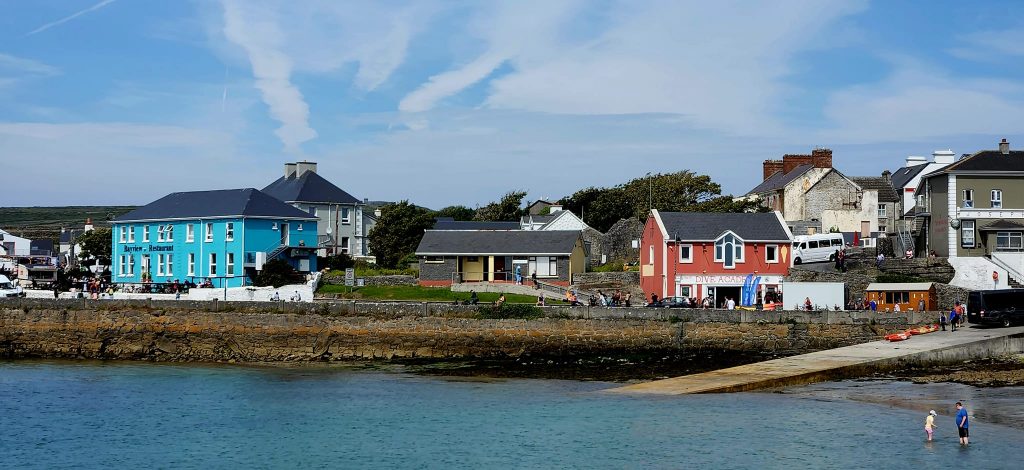
I don’t recall if there was a pilgrimage offered my first year of participation in The Celtic Center’s offerings. But then the pandemic arrived in 2020, removing the possibility of overseas travel.
If you read my previous post, you know the relief I experienced when the decision to go or stay was taken from me for the next two years by the pandemic.
But then the summer of 2022 “loomed.”
Travel around the world opened and the pilgrimage was available once again!
But why am I speaking in gloom-and-doom terms about the trip of a lifetime?
The opportunity to fulfill a bucket list item!
Ireland on a pilgrimage couldn’t be more idyllic!
What was wrong with me?
Kirk encouraged me to go.
My therapist was thrilled for me to go. He knew Kirk. He’d been to Ireland himself. And he too could envision a rewarding, magical, once in a lifetime experience for me there. Well worth whatever it took for me to follow through with the part of me that truly desired the adventure while attending to the parts of me that were insecure and scared.
And then there was my husband’s support.
My husband wanted me to go more than I wanted it for myself!
For a couple of decades, Joseph wanted to share the ancient churches that had deeply moved him on his trip to England years before we met. We’d dreamt of going to England with a side trip to Ireland. But the few times we considered it, life got in the way of our plans.
Though I’d be taking this trip by myself, his enthusiastic support of me was his way of gifting me with one of the things he wanted most for me. Joseph, more than I am, is aware of how combining spirituality with vacations is my ideal reason to travel. So his full enthusiasm came to the surface in under a second at the thought of me taking a pilgrimage to Ireland!
 What I couldn’t know until I took the first flight of the trip was that it would be painful to travel without him. Despite our mutual enthusiasm for me to spend ten days in Ireland, the separation hurt – plain and simple.
What I couldn’t know until I took the first flight of the trip was that it would be painful to travel without him. Despite our mutual enthusiasm for me to spend ten days in Ireland, the separation hurt – plain and simple.
Except for occasional trips I took to visit my folks on my own, the previous twenty-five years had seen us travel together around the United States, Canada, and to island countries south of Florida. On this trip, and apropos for a pilgrimage, traveling without him was an unexpected challenge.
Little did we know how much he’d participate in my day-to-day reality there on Inis Mór with an ocean separating us.
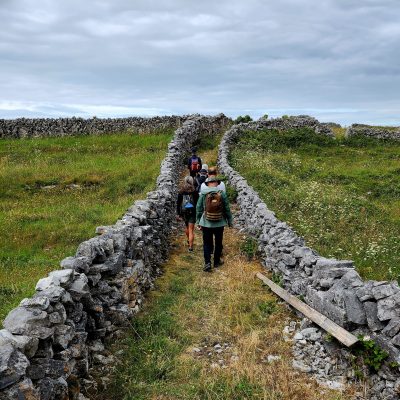 My concerns were not just the issues of a Highly Sensitive Person, which I am.
My concerns were not just the issues of a Highly Sensitive Person, which I am.
Though, as a Highly Sensitive Person, I found all the travel preparations and the travel itself overstimulating, I have health issues that I feared would make me a burden on others.
And I didn’t want to be a burden. I did not want to slow the group down. Of course, I wanted everyone in our group to like me! And I wanted to participate in everything.
To list my health issues with brevity. I have global pain stemming from fibromyalgia (which is mostly under control), osteoarthritis, and localized pain with Achilles tendonitis. A “nervous bladder” has been a lifelong companion.
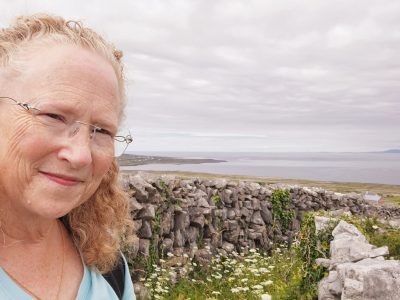 I needed frequent bathroom breaks.
I needed frequent bathroom breaks.
What I wouldn’t discover until I was on the island is that Inis Mór has very few trees or bushes. Out on the walking tours of the ancient Christian churches and monasteries, there are no indoor facilities and no privacy. The stone walls that ribbon Ireland are not tall enough to provide privacy. Though, in some places there are boulders large enough to provide a modicum of privacy.
With no bars or restaurants out on the walks, I spent most of each three-hour morning walking tour in considerable discomfort.
Worsening health issues with even greater potential for embarrassment:
My second morning there, I awoke with a digestive issue I’d never experienced, that only got worse with time. I was scared but didn’t want to receive medical attention unless necessary. Instead, I texted Joseph and asked him to make me an appointment with our doctor for as early after my return home as possible.
That appointment wouldn’t reveal anything. However, an urgent trip to the emergency room six weeks after returning home would.
While in Ireland and unbeknownst to me, I had a stowaway on board. I was carrying around a 22 cm uterine fibroid that was interfering with an ovary, my bladder, and colon. It was about the size of a portable cd player boombox that is popular these days for children.
 I soldiered on.
I soldiered on.
Though what ailed me meant I couldn’t make it to morning meditation and prayer each day, I was present for everything else. Despite my health issues, I enjoyed everything we learned, everything we saw, the people, the Irish brogue, the food, the new friends I was making, and the landscape!
It was magical: the landscape, the towns, and villages, the simple yet elegant, sometime whimsical architecture, the ancient church ruins, and the ancient fort ruins. And the children and teens that don’t seem to have a clue about the history they walk and live on.
Though it was all new to me, there’s something about Ireland that feels like home.
Lost in time and space.
Curiously, every day there I felt I existed out of time.
Only five hours difference separated Joseph and me. I was free by 3 p.m. Ireland time, which was 8 p.m. North Carolina time – perfect for a daily phone call.
Coordinating phone calls was easy, but I remained confused. Confused about the time difference and confused about the space that separated us. I felt lost in time and space.
Even internally, in my mind, spirit, and imagination, I was in a liminal environment that I couldn’t name or resolve.
Here’s how it played out.
Every single night, when taking a shower, getting in under the water I “heard” Elvis in my head singing “Kentucky Rain.”
The first time I thought, “I’m not used to the time change. I do NOT need this ear worm in my head at bedtime!”
But when my shower ended and the water turned off, so did the song.
It happened every single night.
Not with my morning shower! Only with the evening shower, with me in the shower as dusk settled, the sun setting at 10 p.m.
I think Elvis’s “Kentucky Rain” filled my imagination nightly because it’s a song about a man lost in time and space. I mean, he’s walking in the rain days behind his lover who left him, pining for her.
He will never find her.
He is lost in time and space.
The gift of it.
 If this phenomenon was a gift, the gift was that it helped make my mental and emotional states feel less wobbly. Somehow, even though it too was strange, it made my internal state make sense. That, somehow, I wasn’t alone in this internal sense of feeling lost.
If this phenomenon was a gift, the gift was that it helped make my mental and emotional states feel less wobbly. Somehow, even though it too was strange, it made my internal state make sense. That, somehow, I wasn’t alone in this internal sense of feeling lost.
I wasn’t lost. I was simply so far out of my normal life and habits that I was meeting myself in strange and new ways.
I’d say that’s one of the things a spiritual pilgrimage is meant to accomplish. Meeting oneself anew! I just happened to have Elvis along for the ride. A sign my sense of humor was intact.
Liminality and Thin Places
In addition to the time difference, and the liminal feeling dusk at 10 p.m. gives, there was a haunting romantic notion. Whenever I looked across the Atlantic Ocean, it was as if Joseph was just there on the other side, out of reach. The waves seemed to carry my longing for him with them.
That too was liminal in that multiple generations of the Irish watched their family and friends board ships off the Western coast of Ireland, to sail to America. In a sense, my longing might have joined the longing of generations in an empathic/morphic field kind of way.

Longing, dusk, ocean, new friends, crossing the Atlantic for the first time – these were liminal things that I was acutely aware of. They were also thin places.
In Ireland, thin places are where the opportunity to touch the veil that separates this reality from the Holy Mystery resides. Thin places can occur in physical places, internally, or even in the air between people.
Liminal spaces and thin places are anywhere it feels as if you are standing on a threshold between what you know and what you don’t know. Where you’re partly in the earthly realm and partly in another realm that doesn’t have the same solidity you are used to.
Music can transport a person to a threshold where earth and heaven meet! Apparently, even Elvis Presley’s “Kentucky Rain” can (and did) provide a thin place.
Until one day Joseph found a way to pierce that sense of being lost in time and space.
On the fourth day of my trip, which was the second day on Inis Mór, during our phone call he said, “Go outside to the flags.”
“What?”
“Go outside to the flags. There’s a live video camera.”
“Oh, the flags. That makes sense.”
Aran Islands Hotel is a popular destination wedding location. Of course, they have a live web stream outside.
I went to the flags!
Looking for the camera, I walked outside to the flags (of about six countries) – to the wall they stand in front of – and turned to face the front door of the resort. Between me and the camera were picnic tables where about a dozen people relaxed, visiting with one another.
“I see the camera! Can you see me?”
“Wave.”
“Wave?”
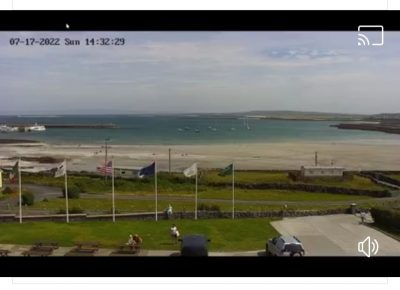
“Yeah, wave at me! No, bigger. Wave really big!”
Feeling self-conscious, laughing, yet trying not to attract attention, I attempted to wave big enough so Joseph could see me at home: live and on his computer screen. I didn’t realize how tiny I was on his screen and just how big he needed me to wave.
It was fun! And for a moment, the liminal bubble I’d been living in burst. For a few minutes we broke through the space/time barrier that physically separated us and we were together!
Somehow, we were together more so than in our afternoon chats on our cell phones.
And even though, with the video camera feed, Joseph could see me while I couldn’t see him; for a few minutes we burst that liminal bubble I’d been trapped in (and to which I would return).
Even now, remembering it as I write, my body relaxes at the memory of feeling, for a moment, that I was home in both North Carolina and on Inis Mór at the same time. A thin place.
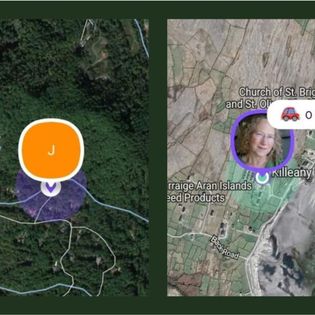
(a screen shot from an app that displays the vast difference in terrain between Joseph at home in verdant North Carolina and me, surrounded by limestone, on Inis Mór! You can make out the rock walls from that far away – the green fields at the bottom third of the image are full of rock fences.)
Sharing the fun with my fellow pilgrims.
That evening at supper, I told everyone about the live video camera and Joseph and I “meeting” there. Some decided to do the same thing with their family members.
There we were, in the age of Zoom and conference calls with family, friends, and colleagues, where we can see each other’s faces fill our screens, delighted over waving to family through what felt like a magical portal. A video camera attached to the roof of our hotel. We couldn’t see them, but our family members could see us.
I think the experience of waving at a live camera where only one person on the receiving end of the image can see the other person waving is an experience reminiscent of the magic of childhood. And, perhaps, in the magic of childhood is a feeling of security and home.
So, what did I get out of my time in Ireland, and the enchantment of Inis Mór in particular? What stirred my heart and spoke to my soul on the pilgrimage itself – other than internal liminal states, physical discomfort, and Elvis singing to me nightly?
The people were friendly – open, kind, affectionate, and forgiving.
In Ireland, you walk on the right side of the road, facing traffic. On sidewalks and inside buildings, people walk the way they drive, on the left. Walking in a crowd, people pass folks to their left, not their right. An American can learn to dance scuttling out of people’s way in Europe!
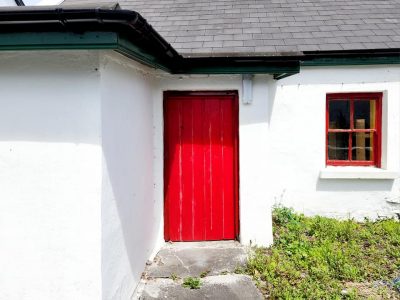 In Ireland, wait staff are paid minimum wage, are not reliant on tips, and so tipping is awkward. It’s OK to do it but it isn’t expected. If you return to the bar an hour later, you might find your tip still sitting there!
In Ireland, wait staff are paid minimum wage, are not reliant on tips, and so tipping is awkward. It’s OK to do it but it isn’t expected. If you return to the bar an hour later, you might find your tip still sitting there!
There are no dollar bills. Instead, they have 2-euro and 1-euro coins. The first time I broke a Є10 buying a delicious Є6 breakfast at Shannon International Airport and only got coins in return, I startled but then chuckled out loud after taking the time to read the coins.
I never received impatience, a cross word, a strange look, or weird energy because I didn’t know these things and needed to learn them on the spot.
In all the restaurants, food portions were ginormous and every dish that wasn’t deep fried seemed to contain bacon. One might not think this about Americans, but we couldn’t finish our meals. Not a word, not a look, not a gesture – everything was fine.
The pilgrimage itself:
 It was enlivening to visit historical places associated with the names of the saints and church leaders we’d studied during the previous three years.
It was enlivening to visit historical places associated with the names of the saints and church leaders we’d studied during the previous three years.
Knowing how many of these sites were built on or near even more ancient sites that were associated with Druid gods and goddesses was mesmerizing.
For instance, throughout Ireland and there on Inis Mór, there are paleolithic burial sites called Passage Tombs. They look like man-made stone caves, sitting out in the middle of fields.
They have three walls, usually made from three large stones, and a stone ceiling. At the back wall of each the ground descends at a slant for the burial of bodies.
I found it awe inspiring to stand near and gaze at a burial structure that dates to prehistoric times. This too is a liminal experience.
A church, a natural spring, and a Hawthorne Tree
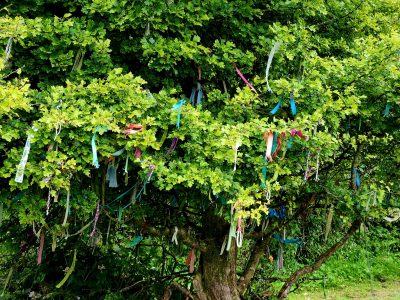 Near one of the ancient churches we visited was an even more ancient well supported by rock walls. There was a Hawthorne tree growing beside it which was used as a prayer tree. The tree was filled with ribbons and trinkets from people having prayed there.
Near one of the ancient churches we visited was an even more ancient well supported by rock walls. There was a Hawthorne tree growing beside it which was used as a prayer tree. The tree was filled with ribbons and trinkets from people having prayed there.
As a group, we participated in a Christian ritual of circling the well three times while praying private prayers. Some used the well water as holy water with which to bless themselves or make a request for healing. And there was time to hang our own ribbons and prayers on the Hawthorne tree, if we wanted to.
 That Hawthorne tree was a thin place!
That Hawthorne tree was a thin place!
I’d taken an old blue jean shirt of Joseph’s and cut two long strips out of it, one for him and one for me. It was going to be meaningful to leave this token of ourselves behind in that tree with prayers attached for our wellbeing.
Finding a place to hang our strips of cloth, I walked in and under branches until I was in the middle of the tree. There I found a branch with space for our blue jean “ribbons.”
Inside the branches of the Hawthorne tree, the air seemed different – holy. As if all the prayers that had ever filled that tree left a tangible imprint. The center of that Hawthorne tree was a thin place within the larger thin place that the well, only feet away, occupied.
And both were thin places within the larger thin place that St. Ciaran’s Church, yards away, occupied.
Those types of trees, often Hawthorns, are called “rag trees.” The idea is that the prayers are granted as the strips of cloth disintegrate. An idea born long before Christianity when the springs and trees were associated with fairies and Druidic gods and goddesses. Back then, the Hawthorne trees were wishing trees.
Even today, that tree and well are a place where the presence of the fae folk is strong!
I found my relationship to the ancient churches odd.
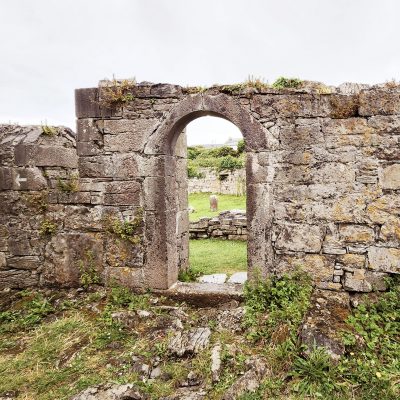 While the ancient churches intrigued me, I wasn’t as moved as I expected to be. Not the way I am moved, even at home in Asheville, for instance, when I visit the Basilica of Saint Lawrence, which is only 114 years old.
While the ancient churches intrigued me, I wasn’t as moved as I expected to be. Not the way I am moved, even at home in Asheville, for instance, when I visit the Basilica of Saint Lawrence, which is only 114 years old.
I think it’s because these ancient Celtic churches and monasteries on Inis Mór don’t have roofs. Given that the original roofs were made of thatch and, of course, couldn’t last.
In very old churches which are fully enclosed structures still in use; I think it is the prayers of the people lifted there over hundreds and thousands of years that leave behind an imprint. An imprint on the soul of the building, especially the sanctuary – that I can feel, and that I honor by adding my own presence and prayers.
That’s my experience. There are many, though, who have the felt sense of history, purpose, sanctity, presence, and other experiences in those ancient churches and monasteries without roofs!
But then there was one altar inside the oldest Christian structure on Inis Mór that captured my imagination and heart.
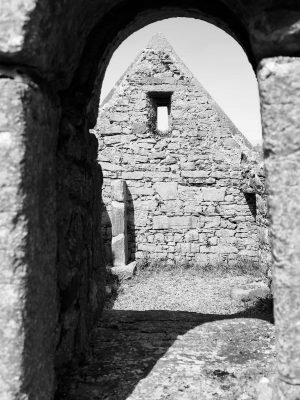 That structure, a small chapel, is the only building left of the first monastery created on Inis Mór. Established by Saint Enda, its name is Teaghlach Éinne (Enda’s Household). A village grew up around Teaghlach Éinne that is still there today. The village’s name is Cill Éinne, which means “Enda’s church.”
That structure, a small chapel, is the only building left of the first monastery created on Inis Mór. Established by Saint Enda, its name is Teaghlach Éinne (Enda’s Household). A village grew up around Teaghlach Éinne that is still there today. The village’s name is Cill Éinne, which means “Enda’s church.”
It’s a tiny church once buried in sand. But now excavated and without a roof, you can walk inside it, look around, meditate, and pray. You can even use the tea candles left by folks that come to pray there. Light a candle for the length of your prayer time, then snuff it out and leave the candle behind for your own or another’s use.
Those used tea candles gave me the sense of a thin place. This place where an ancient monastery, with its roof open to the sky, offers sacred space for folks to offer prayers and mediation here and now.
But those tea candles were not on the altar that captured my soul.
The ancient art of spirals
Taking photographs in the chapel, the left leg of the altar drew my attention. There I came face-to-face with an ancient spiritual symbol that spoke to me as if the symbol itself and I already had a long history – one I must have forgotten.
 Bending down to take a closer look, I heard myself say, “Oh, hello!” as if I were greeting an old friend.
Bending down to take a closer look, I heard myself say, “Oh, hello!” as if I were greeting an old friend.
The left leg of the church’s altar, made of two separate elongated stones joined to one another, had two spirals. One carved into each stone.
The top spiral swirls clockwise while the other swirls counterclockwise. A difference in size and the difference in dimensions and handiwork, suggests each spiral was carved by a different engraver.
Charmed, I’d later learn I was experiencing communion with petroglyphs – Neolithic art etched in stone.
Whether those stones were gathered and used for the left leg of the altar from its inception or used to replace a previous altar leg that had been damaged, it’s possible those stones date back to prehistoric times – many thousands of years before Christianity found its way to Ireland.
Yet there they were, prominently displayed on the church’s altar.
The spiral became a symbol of what I love most about ancient Celtic Christianity: a testament of the choice for integration rather than division.
Integration was at the heart of the first wave of Christianity across Ireland. No one had to preach integration. It occurred naturally.
When the Gospel began to make its way, via St. Patrick and others, to Ireland and its outermost islands, the Druids were the spiritual leaders of Celtic communities.
As Druidic leadership converted to Christianity, they became the abbots and abbesses of the first Christian monasteries in Ireland.
St. Brigid, for instance, was first a Druid leader before becoming a Christian abbess – head of a monastery in Kildare. At the time she became a Druid leader is likely when she took on the name “Brigid,” after the Irish Goddess Brigid. She kept the name after her conversion to Christianity.
Integration
That pair of stone spirals on the left leg of that early Christian altar date back to pre-history, Stone Age people, and Neolithic art.
Art that was
- still appreciated, many thousands of years later and
- embraced as an ancient spiritual – even perhaps religious – symbol for the great mystery that is life, death, and life again.
In ancient Celtic Druidism, the divine feminine is associated with the great mystery that is life, death, and life again.
And so, recall the story of Jesus and how it is all about life, death, and life again. In fact, his mother plays a central role throughout his life, death, and life again.
I don’t think a decision was made to integrate the art of spirals, with their spiritual connotations and similarities with Christian theology. I think the fact they appear on ancient Irish high crosses and on the leg of this altar is a natural and respectful Celtic tradition.
Integration was natural for the ancient Celts.
The embrace between the old and the new was natural during the first centuries that Christianity came alive in Ireland. In fact, ancient Celtic Christians likened their Druidic past to the Hebrew Bible. There the stage was set for the welcoming of Christ into their hearts and lives. More than one Celtic Christian saint proclaimed, “Christ is my Druid!”
Therefore, the spiral, as a symbol of life, death, and life again, is an earth focused and beautiful trinitarian symbol. The fact it wasn’t discarded is remarkable!
What I like about spirals is how the continued use of them points to the beauty of integration.
Turns out, the spiral is a spiritual and religious symbol around the world.
 Spirals exist throughout nature: ocean waves, plants such as ferns and any number of vines, snail shells, seashells, snakes, even curly hair, not to mention galaxies.
Spirals exist throughout nature: ocean waves, plants such as ferns and any number of vines, snail shells, seashells, snakes, even curly hair, not to mention galaxies.
Concentric circles and spirals are found in ancient, prehistoric art all over the world. They remind me of the handprints found in a cave in Argentina where prehistoric people, 10,000 years ago, placed their hands on cave ceilings and then blew a color filled substance at their hands through a type of straw. Prehistoric people created stencils with their hands to leave the art of handprints on their walls and ceilings! That art is still visible today.
It’s as if those handprints were a way of saying, “Look! Here I am!”
Just so, it’s as if the spirals and concentric circles found in prehistoric art were a way of communing with the Divine to say, “There You are!” Or, “I see You!”
“You” as the Divine, the Spirit that flows within and without all creation. The Divine Spirit that flows within the immediacy and intimacy of each one of our very own hearts and minds.
Internal Liminal Spaces
 Throughout my trip to Ireland, I was off kilter, a little imbalanced. I took a leap of faith that the pilgrimage offered something I wanted, even though I didn’t know what that was. It delivered much more than I could have imagined.
Throughout my trip to Ireland, I was off kilter, a little imbalanced. I took a leap of faith that the pilgrimage offered something I wanted, even though I didn’t know what that was. It delivered much more than I could have imagined.
As a highly sensitive person, 24 hours a day I receive innumerable sensory experiences delivered by whatever environment I’m in. True for 62 years now, it is likely the reason why I never wanted to take the leap to travel extensively, where there is a bevy of brand spankin’ new-to-me sensory overload experiences available!
I have never thought to numb out the high sensitivity through substances. What little exposure I’ve had to them made the sensory overload worse, not better.
Rather, talk therapy, journaling, and having empathetic friends with whom to process my experiences as a highly sensitive person – these have been my go-to.
By some grace, in part for being raised in church and in part for how I was raised at home, where spending lots of time in my internal world was accepted; my religious and spiritual encounter with God – with the Divine Mystery – deepened at sixteen and changed the course of my life.
In hindsight I can see that my religious and spiritual expression became Celtic-like at that time. There was nowhere I was that the felt presence of God was not also there, with every person, place, and thing. That is quite a Celtic expression of spirituality. And, for some reason, rather than cultivating it, I received it as a gift of grace.
Thus, I took a pilgrimage to Ireland – to Inis Mór – and fell in love with a place full of ancient history and thin places that align the soul with the Divine Mystery!
I fell in love with paleolithic spirals.
I managed physical pain and discomfort.
Though I love the feeling of liminal space, in Ireland I hung out in it more than I thought I could tolerate!
I was enamored with the people, the landscape, the architecture, and the thrill of being up close and personal with ancient Christian churches and places I’d studied.
Spending time with my friend and our leader, Kirk, meeting new friends I only knew from our Zoom meetings, and making brand new friends; and how quickly we formed a sense of community was magical.
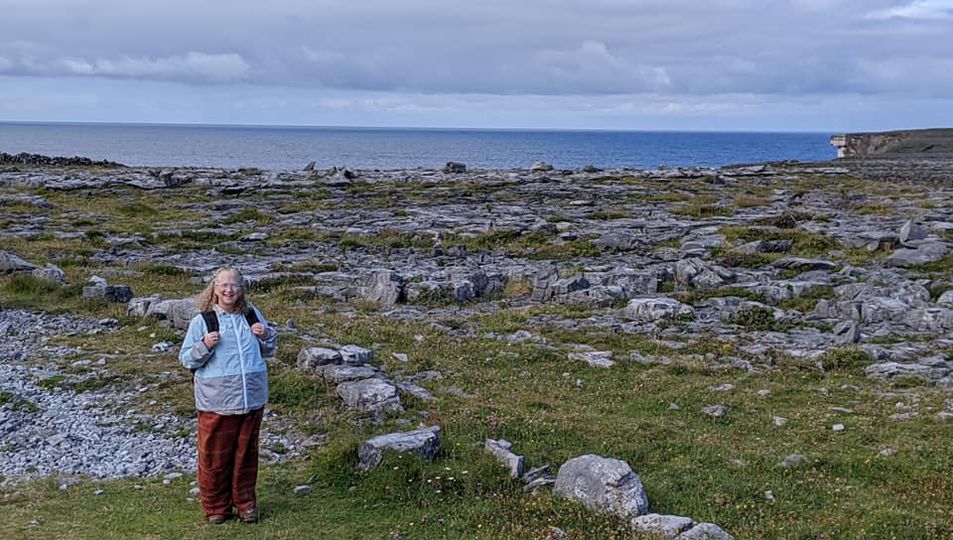
I was stunned by my courage and strength to take the trip.
I think I inspired myself by showing up every day present and embracing what the day had to offer. And doing so despite a great deal of physical discomfort that stretched me emotionally because I was so far away from home.
I got to be up close and personal with the physical remains of history I’d studied, hearing old and new stories of those places and people.
And because I pulled forth my courage and went on this pilgrimage to Inis Mór, I believe my resiliency increased. And that benefitted me for the major surgery that would follow in October, to remove that 22 cm fibroid – my secret stowaway!
My biggest take away from my trip to Ireland comes in the form of a prayer and blessing.
May we all meet our trepidations with courage and the opportunity to grow our resiliency, especially whenever and wherever it seems that just isn’t possible!
Blessings to you,
Sarah Elizabeth
P.S. Travel tips for pilgrimages and/or walking tours in Ireland
- sunscreen
- a hat that shields face and neck
- layers – one of which is light weight rain gear.
- if you are on a walking tour, a foldable, packable cane that is also a stool might be a life saver.
- if you can afford it and if it appeals to you, arrange for a late check in (from the night before) at the airport hotel your first morning there. Stay there for a couple of days. Have no demands on your time. Sleep and adjust to the time change. That may sound like too much luxury and a complete waste of time, but it is especially valuable for Highly Sensitive People. (And it’s what I’m going to do next time! 😉 )

